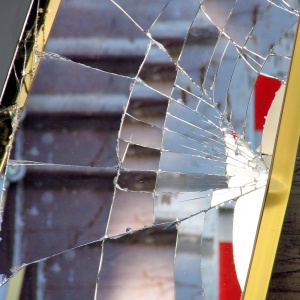Selling your home can be a stressful time, especially if you need every cent of your asking price to finance your move or your next home purchase. There are many ways in which people unwittingly decrease the value of their property. Avoid these mistakes and you’ll be pleasantly amazed at the price your house sells for. Here are some of them:
 Fractured by Peter Kaminski
Fractured by Peter Kaminski
- An inconvenient floor plan: If your rooms are small and bathrooms cramped, it may be a deal breaker for a potential buyer. Everyone loves lots of space, so think of ways to make your rooms larger and airier. Also, layouts that require you to access bedrooms or bathrooms through other rooms will detract from the value of your home.
- Bad do-it-yourself: Remember the sins of the 1970s. Avoid stone cladding and remove period features such as fireplaces and decorative plasterwork. Make sure any home improvements are in keeping with the age and style of the house. Plastic windows and laminate floors may work well in a new flat, but can cheapen a Victorian home. Adding a room extension that occupies the entire garden is also a bad decision.
- A bad roof: Roofs are expensive to replace, and a good roof is considered standard equipment in a house. As a buyer, if you walk into a home and see leaks on the ceiling or hear an inspector mention that the roof is bad, you’d probably take that home off your short list right away. Make sure the roof is at least in acceptable condition before putting your home on the market.
- Bathroom quality: Bathrooms play a crucial part in selling your home. Common problems such as chipped tiles, an old toilet, or lime scale buildup around the bath will have buyers looking for money off your sale price, or even put them off completely. A quick fix here and there could pay off greatly.
- Decoration style: Be sure to get rid of all extreme decorating themes and colours around your house. You may find a Mickey Mouse-themed kitchen the most adorable thing in the world, but a potential buyer will only think about how hard it will be to get rid of it and what it may cost. Be sure to pick a neutral theme, and stick with basic modifications that people can easily adjust and modify themselves when they purchase your home. Remember, first impressions are the most important, so make sure to stick with neutral colours.
- Plants and flowers: They can brighten rooms and make them instantly appealing, but not if they’re dead or dying. The sight of dead or struggling potted plants will affect the buyer’s perception of your home and the way you’ve looked after it—they’re better off in the gargage bin.
- An unkempt yard: Having a front or back yard that is unkempt can definitely decrease the value of your home. For example, if you have large dogs that have turned your nice green yard into mud and dirt, then the next person who moves in will have to do their landscaping all over again, which can be quite a headache (and expense), thereby decreasing the value of your home.
- Bad plumbing: Plumbing problems are an easy way to decrease your home’s value. They can range anywhere from a leaky faucet to a leaky pipe. One of the worst things that can happen to a home is to ignore a plumbing problem. This can result in mold in the home which can make a home virtually unsaleable.
- The location: Unfortunately, there’s not really much you can do about this. Potential buyers consider the location of a home to be one of the most important elements when purchasing. Things such as good schools, a quiet environment, and close proximity to shopping and public transit are what people usually look for. A beautiful example of this is a well-known case of one neighbourhood with a significant difference in value between the even and odd-numbered houses. The reason? The odd-numbered ones backed on to an interstate highway and some ugly utility lines, and the result was that the even-numbered houses were worth about 10 percent more than the odd-numbered ones.
- Bathroom/kitchen carpets: Carpets in your kitchen and bathroom may feel good for your feet, but they tend to soak up moisture and fumes and are more difficult to keep clean, leading to damp, mouldy floors that are not likely to appeal. Also, carpets in kitchens are likely spattered with various food stains, so you’re definitely better off with a hardwood floor or tile in either of these two areas.

Great post! Thanks for sharing.